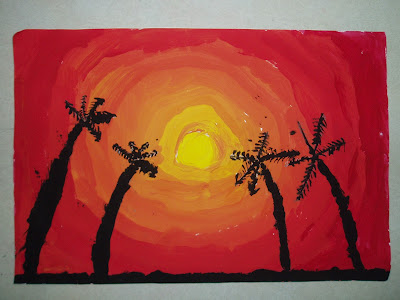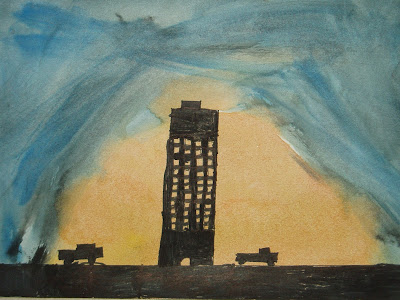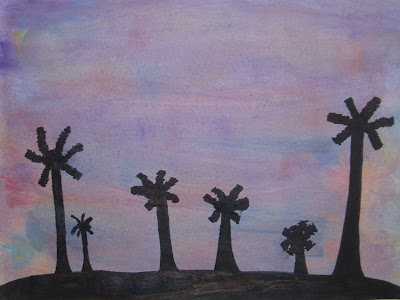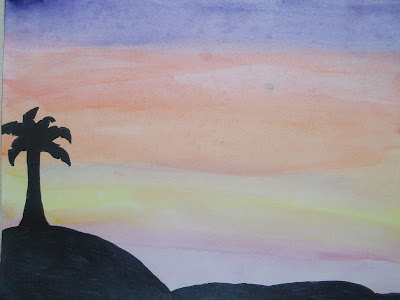This is a fun project on mixing colors that I got from a workshop at our annual AEAI convention. The students begin by painting a yellow circle in the middle of their page, and then stir a little bit of red paint into it to make yellow-orange. They paint a yellow-orange ring around the yellow circle, and then keep stirring red into their paint, and keep painting larger and larger rings that are successively more red. By the time the students get to the end of the page, there is so much red in their yellow paint, that it just looks like red, not red-orange. The results are quite elegant, and most of the students really enjoyed working on this project and learning how to mix different shades of orange.
Wednesday, December 21, 2011
Monday, December 19, 2011
Kindergarten Cardinals
This is a fun project that incorporates Indiana state history since the cardinal is our state bird. I usually try to steer away from step-by-step projects where every student's picture looks the same, but somehow the students' birds always turn out unique. The first step is to draw a big letter "D" and a tall, skinny rectangle on a piece of red paper, and to cut those shapes out. Since the students' outlines vary, the birds come in all different shapes and sizes! Then, the students use crayons to add a beak, eyes, wing, legs, and a little branch for him to sit on. The following week, we use white paint to add snow. I always encourage the students to use just the tip of their brush to make tiny snowflakes, but of course several students always mash their brush down and make huge, messy snowballs.
Friday, December 16, 2011
Tattling
It is every 1st grader and kindergartner’s delight to inform a teacher that a fellow classmate said a naughty word. Over the past few months, I have learned to decode what it means if someone said the “s-word” (stupid) or the “f-word” (fat). Sometimes the letter preceding “-word” sets my mind spinning, and I cannot decipher it. In those situations, my solution is to look at the student sternly and say, “I better not ever hear you say that word. Do you understand?” Of course there’s a chance I wouldn’t know if I hear it, since some words forbidden in elementary classrooms are part of my every-day vocabulary, but so far it has worked fine.
When I was showing the kindergartners Rose Period artwork by Picasso last week, I displayed Fat Clown Seated. I didn’t mention the painting’s title, and halfway through our discussion on Rose Period art, one student raised his hand, and informed me, “Jack just said that clown is fat!” He said it loudly and confidently, not even using the euphemism “f-word” to describe the taboo term.
“Well, the clown is fat,” I replied, and gasps erupted from the girls, and giggles from the boys. I hurriedly went on with the discussion, not sure if I had handled the situation correctly.
Tattling is not something I condone, but I have found that if I do not immediately reprimand the child being tattled on, the tattle-worthy behavior will continue and cause further disruptions and more tattles. Some students tattle just for the thrill of it, but most students have a legitimate concern. Today, I had one student tell me, “Sophie is tattling for no reason, and I didn’t do anything!” She was clearly trying to cover her back, but it was unnecessary as the purported tattling never reached my ears.
Thankfully, tattling goes out of style around 2nd grade, and my ears can rest from the never-ending chore of listening to “he said” and “she said”. Unfortunately, by 6th grade, I have new challenges as the terms “s-word” and “f-word” acquire new meanings. When those words are used in Miss Young’s art room, the students are sent straight to the office, and they can be sure their parents will be hearing about their behavior.
Subscribe to:
Comments (Atom)





















































